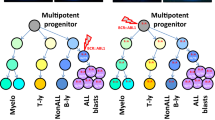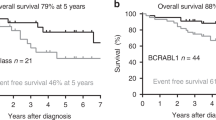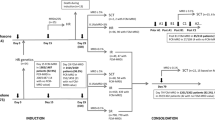Abstract
Philadelphia chromosome-positive (Ph+) acute lymphoblastic leukemia (ALL) has a dismal prognosis. We prospectively evaluated minimal residual disease (MRD) by measuring BCR/ABL levels with a quantitative real-time PCR procedure after induction and after consolidation in 45 adults with Ph+ ALL who obtained complete hematological remission after a high-dose daunorubicin induction schedule. At diagnosis, the mean BCR-ABL/GUS ratio was 1.55±1.78. A total of 42 patients evaluable for outcome analysis were operationally divided into two MRD groups: good molecular responders (GMRs; n=28) with >2 log reduction of residual disease after induction and >3 log reduction after consolidation therapy, and poor molecular responders (PMRs; n=14) who, despite complete hematological remission, had a higher MRD at both time points. In GMR, the actuarial probability of relapse-free, disease-free and overall survival at two years was 38, 27 and 48%, respectively, as compared to 0, 0 and 0% in PMR (P=0.0035, 0.0076 and 0.0026, respectively). Salvage therapy induced a second sustained complete hematological remission in three GMR patients, but in no PMR patient. Our data indicate that, as already shown in children, adult Ph+ ALL patients have a heterogeneous sensitivity to treatment, and that early quantification of residual disease is a prognostic parameter in this disease.
This is a preview of subscription content, access via your institution
Access options
Subscribe to this journal
Receive 12 print issues and online access
$259.00 per year
only $21.58 per issue
Buy this article
- Purchase on Springer Link
- Instant access to full article PDF
Prices may be subject to local taxes which are calculated during checkout


Similar content being viewed by others
References
Kantarjian HM, Talpaz M, Dhingra K, Estey E, Keating MJ, Ku S et al. Significance of the P210 vs P190 molecular abnormalities in adults with Philadelphia chromosome-positive acute leukemia. Blood 1991; 78: 2411–2418.
Gleissner B, Gokbuget N, Bartram CR, Janssen B, Rieder H, Janssen JW et al. Leading prognostic relevance of the BCR-ABL translocation in adult acute B-lineage lymphoblastic leukemia: a prospective study of the German Multicenter Trial Group and confirmed polymerase chain reaction analysis. Blood 2002; 99: 1536–1543.
Dombret H, Gabert J, Boiron JM, Rigal-Huguet F, Blaise D, Thomas X et al. Outcome of treatment in adults with Philadelphia chromosome-positive acute lymphoblastic leukemia – results of the prospective multicenter LALA-94 trial. Blood 2002; 100: 2357–2366.
Annino L, Ferrari A, Cedrone M, Giona F, Lo Coco F, Meloni G et al. Adult Philadelphia-chromosome-positive acute lymphoblastic leukemia: experience of treatments during a ten-year period. Leukemia 1994; 8: 664–667.
Pane F, Intrieri M, Quintarelli C, Izzo B, Muccioli GC, Salvatore F . BCR/ABL genes and leukemic phenotype: from molecular mechanisms to clinical correlations. Oncogene 2002; 21: 8652–8667.
Li S, Ilaria Jr RL, Million RP, Daley GQ, Van Etten RA . The P190, P210, and P230 forms of the BCR/ABL oncogene induce a similar chronic myeloid leukemia-like syndrome in mice but have different lymphoid leukemogenic activity. J Exp Med 1999; 189: 1399–1412.
Quackenbush RC, Reuther GW, Miller JP, Courtney KD, Pear WS, Pendergast AM . Analysis of the biologic properties of p230 Bcr-Abl reveals unique and overlapping properties with the oncogenic p185 and p210 Bcr-Abl tyrosine kinases. Blood 2000; 95: 2913–2921.
Brisco MJ, Condon J, Hughes E, Neoh SH, Sykes PJ, Seshadri R et al. Outcome prediction in childhood acute lymphoblastic leukaemia by molecular quantification of residual disease at the end of induction. Lancet 1994; 343: 196–200.
Gruhn B, Hongeng S, Yi H, Hancock ML, Rubnitz JE, Neale GA et al. Minimal residual disease after intensive induction therapy in childhood acute lymphoblastic leukemia predicts outcome. Leukemia 1998; 12: 675–681.
Cimino G, Elia L, Mancini M, Annino L, Anaclerico B, Fazi P et al. Clinico-biologic features and treatment outcome of adult pro-B-ALL patients enrolled in the GIMEMA 0496 study: absence of the ALL1/AF4 and of the BCR/ABL fusion genes correlates with a significantly better clinical outcome. Blood 2003; 102: 2014–2020.
van Dongen JJ, Macintyre EA, Gabert JA, Delabesse E, Rossi V, Saglio G et al. Standardized RT-PCR analysis of fusion gene transcripts from chromosome aberrations in acute leukemia for detection of minimal residual disease. Report of the BIOMED-1 Concerted Action: investigation of minimal residual disease in acute leukemia. Leukemia 1999; 13: 1901–1928.
Gabert J, Beillard E, van der Velden VH, Bi W, Grimwade D, Pallisgaard N et al. Standardization and quality control studies of ‘real-time’ quantitative reverse transcriptase polymerase chain reaction of fusion gene transcripts for residual disease detection in leukemia – a Europe Against Cancer program. Leukemia 2003; 17: 2318–2357.
Saglio G, Pane F, Gottardi E, Frigeri F, Buonaiuto MR, Guerrasio A et al. Consistent amounts of acute leukemia-associated P190BCR/ABL transcripts are expressed by chronic myelogenous leukemia patients at diagnosis. Blood 1996; 87: 1075–1080.
Arico M, Valsecchi MG, Camitta B, Schrappe M, Chessells J, Baruchel A et al. Outcome of treatment in children with Philadelphia chromosome-positive acute lymphoblastic leukemia. N Engl J Med 2000; 342: 998–1006.
Hochhaus A . A further milestone towards comprehensive standardization of quantitative RT-PCR protocols for leukemic fusion gene transcripts has been reached. Leukemia 2003; 17: 2383–2384.
van Dongen JJ, Seriu T, Panzer-Grumayer ER, Biondi A, Pongers-Willemse MJ, Corral L et al. Prognostic value of minimal residual disease in acute lymphoblastic leukaemia in childhood. Lancet 1998; 352: 1731–1738.
Cave H, van der Werff ten Bosch J, Suciu S, Guidal C, Waterkeyn C, Otten J et al. Clinical significance of minimal residual disease in childhood acute lymphoblastic leukemia. European Organization for Research and Treatment of Cancer – Childhood Leukemia Cooperative Group. N Engl J Med 1998; 339: 591–598.
Biondi A, Valsecchi MG, Seriu T, D'Aniello E, Willemse MJ, Fasching K et al. Molecular detection of minimal residual disease is a strong predictive factor of relapse in childhood B-lineage acute lymphoblastic leukemia with medium risk features. A case control study of the International BFM study group. Leukemia 2000; 14: 1939–1943.
Panzer-Grumayer ER, Schneider M, Panzer S, Fasching K, Gadner H . Rapid molecular response during early induction chemotherapy predicts a good outcome in childhood acute lymphoblastic leukemia. Blood 2000; 95: 790–794.
Chao NJ, Blume KG, Forman SJ, Snyder DS . Long-term follow-up of allogeneic bone marrow recipients for Philadelphia chromosome-positive acute lymphoblastic leukemia. Blood 1995; 85: 3353–3354.
Thomas X, Thiebaut A, Olteanu N, Danaila C, Charrin C, Archimbaud E et al. Philadelphia chromosome positive adult acute lymphoblastic leukemia: characteristics, prognostic factors and treatment outcome. Hematol Cell Ther 1998; 40: 119–128.
Hongo T, Yamada S, Yajima S, Watanabe C, Fujii Y, Kawasaki H et al. Biological characteristics and prognostic value of in vitro three-drug resistance to prednisolone, L-asparaginase, and vincristine in childhood acute lymphoblastic leukemia. Int J Hematol 1999; 70: 268–277.
Fine BM, Stanulla M, Schrappe M, Ho M, Viehmann S, Harbott J et al. Gene expression patterns associated with recurrent chromosomal translocations in acute lymphoblastic leukemia. Blood 2004; 103: 1043–1049.
Schrappe M, Arico M, Harbott J, Biondi A, Zimmermann M, Conter V et al. Philadelphia chromosome-positive (Ph+) childhood acute lymphoblastic leukemia: good initial steroid response allows early prediction of a favorable treatment outcome. Blood 1998; 92: 2730–2741.
Cazzaniga G, Lanciotti M, Rossi V, Di Martino D, Arico M, Valsecchi MG et al. Prospective molecular monitoring of BCR/ABL transcript in children with Ph+ acute lymphoblastic leukaemia unravels differences in treatment response. Br J Haematol 2002; 119: 445–453.
Radich JP, Kopecky KJ, Boldt DH, Head D, Slovak ML, Babu R et al. Detection of BCR-ABL fusion genes in adult acute lymphoblastic leukemia by the polymerase chain reaction. Leukemia 1994; 8: 1688–1695.
Brisco MJ, Sykes PJ, Dolman G, Neoh SH, Hughes E, Peng LM . Effect of the Philadelphia chromosome on minimal residual disease in acute lymphoblastic leukemia. Leukemia 1997; 11: 1497–1500.
Annino L, Ferrari A, Lamanda M, Mandelli F, Lo Coco F, Pane F . PCR-detectable transcripts in long-term remission of P190(BCR/ABL)-positive acute lymphoblastic leukemia. Blood 2000; 95: 4018–4019.
Radich J, Gehly G, Lee A, Avery R, Bryant E, Edmands S et al. Detection of bcr-abl transcripts in Philadelphia chromosome-positive acute lymphoblastic leukemia after marrow transplantation. Blood 1997; 89: 2602–2609.
Kroger N, Kruger W, Wacker-Backhaus G, Hegewisch-Becker S, Stockschlader M, Fuchs N et al. Intensified conditioning regimen in bone marrow transplantation for Philadelphia chromosome-positive acute lymphoblastic leukemia. Bone Marrow Transplant 1998; 22: 1029–1033.
Mitterbauer G, Nemeth P, Wacha S, Cross NC, Schwarzinger I, Jaeger U et al. Quantification of minimal residual disease in patients with BCR-ABL-positive acute lymphoblastic leukaemia using quantitative competitive polymerase chain reaction. Br J Haematol 1999; 106: 634–643.
O'Brien SG, Guilhot F, Larson RA, Gathmann I, Baccarani M, Cervantes F et al. Imatinib compared with interferon and low-dose cytarabine for newly diagnosed chronic-phase chronic myeloid leukemia. N Engl J Med 2003; 348: 994–1004.
Rosti G, Martinelli G, Bassi S, Amabile M, Trabacchi E, Giannini B et al. Molecular response to imatinib in late chronic-phase chronic myeloid leukemia. Blood 2004; 103: 2284–2290.
Ottmann OG, Druker BJ, Sawyers CL, Goldman JM, Reiffers J, Silver RT et al. A phase 2 study of imatinib in patients with relapsed or refractory Philadelphia chromosome-positive acute lymphoid leukemias. Blood 2002; 100: 1965–1971.
Thomas DA, Faderl S, Cortes J, O'Brien S, Giles FJ, Kornblau SM et al. Treatment of Philadelphia chromosome-positive acute lymphocytic leukemia with hyper-CVAD and imatinib mesylate. Blood 2004; 103: 4396–4407.
Author information
Authors and Affiliations
Consortia
Corresponding author
Additional information
Supported by Associazione Italiana per la Ricerca sul Cancro (AIRC), and COFIN, Ministero della Salute (Roma), Ministero dell'Istruzione e Ricerca Scientifica (MIUR), Regione Campania, Intas (Brussel), EurLeukemiaNet (Brussel), Biogem (Avellino).
Appendix A1
Appendix A1
Participating centers and physicians in the GIMEMA study were Alessandro Levis, Ospedale SS Antonio e Biagio, Alessandria; Pietro Leoni, Nuovo Ospedale Torrette, Ancona; Ettore Volpe, AOSG Moscati, Avellino; Umberto Tirelli, CRO Unita' Operativa Leucemia, Aviano; Vincenzo Liso, Ematologia-Universita' degli Studi, Bari; Michele Baccarani, Istituto di Ematologia L&A Seragnoli, Bologna; Giovanni Quarta, Azienda Ospedaliera ‘A: Di Summa’, Brindisi; Rosario Giustolisi, Ospedale Ferrarotto, Catania; Antonio Peta, Ospedale A Pugliese, Catanzaro; Andrea Gallamini, Ospedale S Croce, Cuneo; Gianluigi Castoldi, Arcispedale S Anna, Ferrara; Alberto Bosi, Ematologia-Policlinico di Careggi, Florence; Ruggerro Mozzana, Ospedale S Antonio Abate, Gallarate, Gino Santini, Ospedale S Martino, Genoa; Franco Patrone, Ematologia-Universita' degli Studi, Genoa; Angelo De Blasio, Ospedale S Maria Goretti, Latina; Giulio Nalli, Ospedale Maggiore, Lodi; Marco Bregni, Istututo di Ricerca e Cura a Carattere Scientifico San Raffaele, Milan; Giuseppe Torelli, Universita' degli Studi, Modena; Marco Montanaro, Ospedale Civile, Montefiascone; Eustachio Miraglia, Ospedale S Giovanni Bosco, Napoli; Felicetto Ferrara, Ospedale A Cardarelli, Napoli; Bruno Rotoli, Universita' Federico II, Napoli;Vincenzo Mettiver, Divisione TERE-Ospedale A Carderelli, Napoli; Enrica Morra, Ospedale Niguarda ‘Ca' Grande’, Milan; Giancarlo Avanzi, Ospedale Maggiore della Carita', Novara; Attilio Gabbas, Ospedale S Francesco, Nuoro; Giuseppe Saglio, AOS Luigi Gonzaga, Orbassano-Turin; Salvatore Mirto, Ospedale Cervello, Palermo; Guglielmo Mariani, Universita' degli Studi, Palermo; Pietro Citarella, Universita' degli Studi, Palermo; Edoardo Ascari, IRCCS S Matteo, Pavia; Massimo Martelli, Policlinico Monteluce; Perugia, Giuseppe Visani, Ospedale S Salvatore, Pesaro; Giuseppe Fioritoni, Ospedale Civile, Pescara; Francesco Ricciuti, Ospedale S Carlo, Potenza; Francesco Nobile, AO Bianchi-Melacrino-Morelli, Reggio Calabria; Luigi Gugliotta, Arcispedale S Maria Nuova, Reggio Emilia; Franco Mandelli, Universita' ‘La Sapienza’, Rome; Giuseppe Leone, Universita' Cattolica del Sacro Cuore, Rome; Sergio Amadori, Ospedale S Eugenio, Rome; A Michele Carella, Ospedale Casa Sollievo Della Sofferenza, San Giovanni Rotondo; Maurizio Longinotti, Universita' degli Studi, Sassari; Francesco Lauria, AOA Sclavo, Siena; Dr Patrizio Mazza, Ospedale SS Annunziata, Taranto; Mario Boccadoro, Ospedale S Giovanni, Turin; Eugenio Gallo, Opsedale ‘le Molinette’, Turin and Giovanni Pizzolo, Policlinico GB Rossi, Verona; Italy.
Rights and permissions
About this article
Cite this article
Pane, F., Cimino, G., Izzo, B. et al. Significant reduction of the hybrid BCR/ABL transcripts after induction and consolidation therapy is a powerful predictor of treatment response in adult Philadelphia-positive acute lymphoblastic leukemia. Leukemia 19, 628–635 (2005). https://doi.org/10.1038/sj.leu.2403683
Received:
Accepted:
Published:
Issue Date:
DOI: https://doi.org/10.1038/sj.leu.2403683
Keywords
This article is cited by
-
MRD in ALL: Optimization and Innovations
Current Hematologic Malignancy Reports (2022)
-
Treatment and monitoring of Philadelphia chromosome-positive leukemia patients: recent advances and remaining challenges
Journal of Hematology & Oncology (2019)
-
Hypermethylation of p15 gene associated with an inferior poor long-term outcome in childhood acute lymphoblastic leukemia
Journal of Cancer Research and Clinical Oncology (2016)
-
Presence of CD34+CD38−CD58− leukemia-propagating cells at diagnosis identifies patients at high risk of relapse with Ph chromosome-positive ALL after allo-hematopoietic SCT
Bone Marrow Transplantation (2015)
-
Effects of conditioning intensity in allogeneic stem cell transplantation for Philadelphia chromosome-positive acute lymphoblastic leukemia
International Journal of Hematology (2015)



